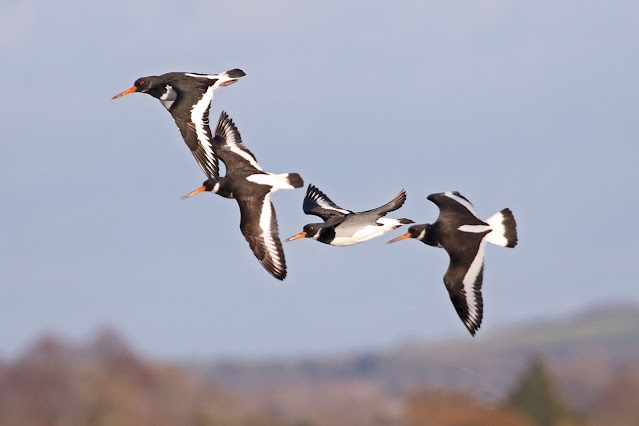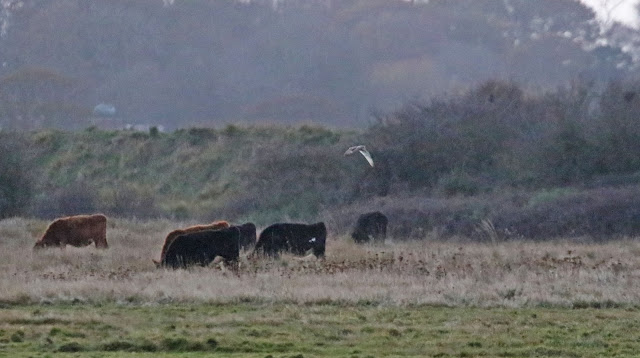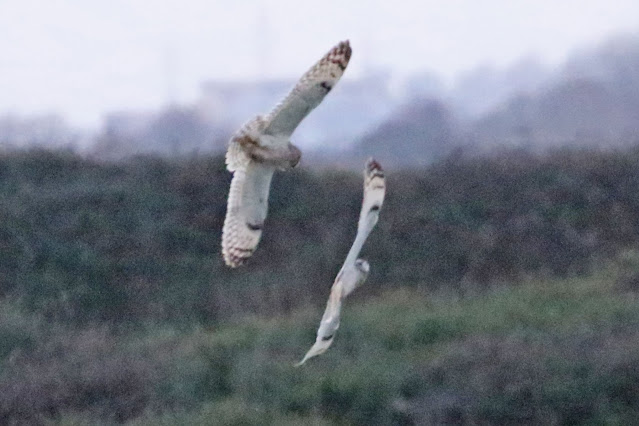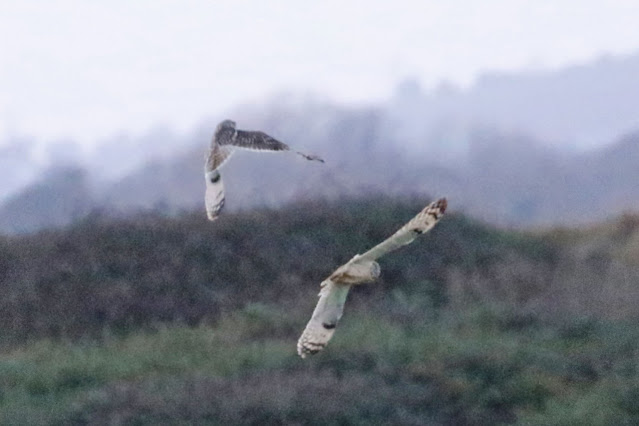The early starts of the spring and summer are wonderful, but can be exhausting at the end of the day. At this time of the year away before dawn means getting a lie in compared with the weekly waking times. And so at just around 7:15 I was heading out of Corhampton on the A32 and coming upon a Barn Owl flying alongside the road side. At one point we were travelling along together and the owl turned to look at me.
I can only assume the owl was taking the opportunity to hunt as the rain overnight had just eased, there was though a breeze that was throwing it about as it flew with rapid wing beats. Hoping that the owl was a good omen for the rest of the day I arrived at the sea wall at Hill Head just before dawn, the tide was rising, but there was still some of the shingle belonging to the rainbow bar showing. As I put on my boots a familiar call from below the sea wall had me grabbing the camera.
A flock of Sanderling had been flushed from the beach by a person clearing rubbish and had settled on the beach right by where I had parked. How could I resist.
Maybe because they are more approachable than any other wader, or maybe it is the silver plumage, or the clockwork like activity that makes them so irresistible, I don't know but I just have to photograph them. The numbers here at Hill Head have built up considerably and the high tide roosts have produced counts of over 200.
Ian arrived with me down on the beach. The Sanderling flew off again and I joined him on the sea wall where Eider were moving into Southampton Water, passing close in.
|We picked up a Marsh Harrier sat in one of the bushes in the middle of the reed bed on the reserve, but apart from the Eider offshore there was very little movement at all. The tide though was pushing the Sanderling closer up the beach and with little else to distract us it was back to the Sanderling.
Different size canvases help to create a different picture, the beach pebbles and shells creating the scene.
Here the breeze lifting the feathers.
Sea weed too can enhance the scene.
The last one today I promise!
Pulling away from the Sanderling the sun was starting to break through the clouds, it doesn't get very high at this time of year and this provides some glorious winter light throughout the day, but specially at the start and end of the day. Here a golden sky and clouds highlights the Isle of Wight Ferry crossing from Portsmouth.
While here a freight ship is entering the Solent heading for Southampton Water
We decided to walk up to the Brownwich Cliffs where we hoped we would get a better view, the height compensating for the choppy water that was out in the Solent, a result of both high tide and the stiff north west breeze.
The height was good but the problem was there were no birds about. All we could find was a very distant group of Eider and a single Great Crested Grebe. Mark then picked up a very distant Diver that was probably a Red-throated Diver moving west and then into Southampton Water. Not what we had expected after the reports of Scoter through the week.
With the reserve now open It was time once again to try for the Jack Snipe that seemed to show when we were not about, this would be my third attempt. It was now quite a lovely day, cold in the stiff wind but lovely to see blue skies and sunshine, although the low sun was going to be a challenge if the snipe did appear. As we approached the Spurgin hide we were informed by some one leaving that the Jack Snipe was showing well, how many times had I heard that!
Jack Snipe are very elusive birds, extremely difficult to see as they rely heavily onthe fantastic camouflaged plumage. It was only this year that I managed to get a good, if not distant view of one at Titchwell in Norfolk. Then it wasn't possible to photograph and almost directly after seeing it through another birder's 'scope it flew off. Prior to that it was always a flushed bird that broke cover from beneath my feet. The Titchfield bird has shown well for many and close enough for acceptable pictures, so we both were keen to catch up, but as we entered the hide those dreaded words "showing well" echoed in my mind!
Settling on to the bench, the only person in the hide attempted to give directions as to where the Jack Snipe was. After looking in the completely wrong place I finally managed to find it, a little further back than I had hoped for and to be fair the only reason I knew it was a Jack Snipe was down to the continual "bobbing". It is there in the middle of the image, the gold stripes showing well as it bobbed, but no sign of the head or bill.
It crept among the reeds and grass, bobbing as it went but staying well under cover, I wasn't sure if this was what "showing well" meant. Then as a new visitor to the hide arrived it shot away to the right and into the complete cover of the denser reeds. Would it come back out, we were in for the long run, well at least until lunch time.
Pings from across the reed bed alerted us to Bearded Tits and we watched as at least four flew into the reeds at the back of where the Jack Snipe had been. The breeze was very strong and in these conditions you would not expect to see them at the top of the reeds, but when the wind eased they would appear.
At least one of them was a male.
Snipe could be seen at the back of the cleared patch, but these were Common Snipe.
Then two of the hide occupants were getting animated about something but keeping quiet, We couldn't see anything, so in the end I had to ask and yes they were seeing the Jack Snipe and it was out in the open now and much closer.
The light as we had feared was not good but the views were excellent, it probed and bobbed almost in unison, moving slowly around the tufts of cut reeds.
Then a whole bird in view.
The
Jack Snipe is a small wader, about two thirds the size of a common snipe, which
it resembles in plumage. The upper-parts are brown with golden stripes, the
belly is white and the breast is buff with thin dark streaks.
Compared
to a common snipe, the bill is much shorter with a relatively deeper base, and
the top of the head is all dark, lacking the golden crown stripe. Also, the
pale band above the eye (the supercilium) is split in two by a thin dark line,
which looks a little like an eyebrow. The “bouncing” feeding action is also often
distinctive, although beware Common Snipe will sometimes bob slightly as well.
Here you can see the flexibility of the bill as the bird probed the marshy water.
The "bobbing" feels exhausting as we watched but it is a very important behaviour for the Jack Snipe. The ”bouncing” or “bobbing” action is due to the fact that most
birds don't have binocular vision and need some other way of assessing
distances. Jack Snipe bob rapidly so
that their monocular vision can act in a binocular fashion, allowing them to
judge distances and depth of field in their immediate environs.
By bobbing they're using the parallax method, shifting their
viewpoint then things at different distances seem to move relative to each
other (the bigger the movement the further they are apart). Moving from side to
side would be no good because they would be moving in the same direction as
their eyes are pointing, and there would be no parallax effect, in order to
achieve this it has to be up and down.
The name “Jack” may refer to the comparatively small size of
the bird and the comparison with the Common Snipe. The “jack” in the game
of bowls is the smallest of the balls used, and fishermen often refer
to the young and small Pike as “Jack Pikes”.
As mentioned earlier, Jack Snipe are reluctant to fly from cover, preferring to
hunker down and trust to their impressive camouflage. They will only flush when
almost trodden on, usually only flying a short distance before dropping back
into cover. Common snipe tend to flush much earlier, calling as they take to
the air and then flying high and zigzagging erratically.
This image shows how well the bird can just melt into the background.
It continued to "bob" even as it preened, but then it settled down and sat motionless probably enjoying the sunshine. It wasn't going to get much better than what we had experienced, so we decided to head around to the Meon Shore Hide. Water levels were still high and there were plenty of duck on the south scrape. Close in, on what was left of the island in front of the hide a Lapwing stood in the midday sunshine.
Also in the sunshine, Gadwall
Many duck sheltering from the wind by huddling up against the reeds in the south west corner of the scrape.
At high tide the Oystercatcher use the scrape to roost while the sea covers the mud and beach.
Drake Shoveler looking superb in the sunshine.
Teal looking splendid in the sunshine.
There appeared to be many more drake Teal than females and there were little groups of drakes whistling and displaying with their neck stretches and head bobs in front of the females, one group consisting of ten drakes to one female.
Time then for some lunch and then a trip just over the border to Thorney Island in West Sussex. Not one of our favourite locations, mainly due to a very long and hot search for an Osprey in July 2015. It is a large area and if you circumnavigate the island its a long way. Fortunately what we were going for was in a specific location and not to far from the road. Up to five Short-eared Owls have been present for a few weeks now.
They hunt in the late afternoon around the Great Deeps an area of rough grass and pasture. We managed to find a parking place and set off for the western side of the island and up on to the sea wall. The tide was still very high and the wind was much stronger than we had experienced at Hill Head. In fact so strong we decided to drop down to the path using the sea wall as shelter. Walking south into the low sun the reeds looked quite special
With the tide still high the gullies and streams were busy with waders on the mud and duck in the water. The rough grass was perfect with tall grass and many tufts and ant hills, perfect ground for the rodents the owls would hunt. I say would because the wind was very strong and owls are not lovers of these conditions. It didn't seem to bother a Marsh Harrier though that drifted over the distant trees and reed beds.
We walked to view the Great Deeps, a stretch of water that separates Thorney Island from the main land, although the water level is controlled by a sluice and gate on both sides of the island. Both the duck and waders were sensing the tide beginning to fall and birds started to move from the Deeps out into Chichester Harbour. First to move were the Redshank.
Then many Wigeon coming from the back of the Deeps.
Three Greenshank called loudly as they flew around the area before too, heading out into the harbour.
This was the first Black-tailed Godwit of the day and the only one seen from the west side of the island.
Two Great Crested Grebes were diving close to where the water was flowing through the sluice into the lake.
Duck of interest kept much to the back of the Deeps. There was a pair of Goldeneye, my first of the second winter and four Red-breasted Mergansers. The most numerous wader to leave was of course the Oystercatcher.
Dunlin also would appear as if from nowhere.
I don't often photograph Cormorant in flight so today there was an opportunity.
Then we noticed some activity in the fields beyond the road, all of the duck went up as did a large flock of Black-tailed Godwits. It looked like the Marsh Harrier was the reason, but there was also another bird of prey with it. We thought maybe two harriers but then colour and wing shape suggested owl. Ian took some photographs and on checking them, sure enough on of the blurry images could only be a Short-eared Owl.
We now had a decision to make. Was there more shelter on the other side? Was the sighting of one owl reason to suspect there could be others? We decided yes to both questions and set off to walk back. We found a break in the hedge that overlooked more suitable rough grass that was a little sheltered and decided that this was the place to be. The wader flock had gone but there was still plenty of duck about.
A shape distantly on the ground turned out to be a Peregrine, but it stayed in place not moving. A Marsh Harrier came across the reeds scattering once again the duck.
From the road we could continue to check the west side of the island although the sun made viewing difficult. It was during one of these checks by Ian that an egret flew across the marsh on the east side and settled on the water trough. I almost ignored it, assuming Little Egret, but then realised that it had a yellow bill. A Cattle Egret.
It then flew cross the road and could be seen mixing with the cattle in the field.
With the light fading we were becoming resigned to the fact that the owls were reluctant to come out in the wind. The Peregrine though took to entertaining us as it made little sorties across the marsh and water scattering the duck before returning a little closer to us on the marsh.
Here just returning from one of it' little sorties
A group of about forty Avocet flew around the marsh before flying away into the harbour on the east side. Avocet have been uncommon along the south coast in Hampshire so it was good to see a sizeable flock here. There was still no sign of any owls, but at least we were comforted by the fact one or two persons had come over from the west side and hadn't seen any owls either
Although not sunset yet the sun finally sank behind cloud away to the west and with it the wind dropped. This was quite noticeable, one moment it was blowing the next the grasses were still. The light was not good though. It was my turn to check the west side and I suppose our worst fears were realised as I picked up a single Short-eared Owl hunting around the bushes and long grass close to the west sea wall.
We watched, cursing as it flew in front of watches o the sea wall, then fortunately it started to head towards us, coming low over the lower grass it put up another owl and the two tangled in the air.
The light was rubbish but at least we were getting a good view.
One then gained height before dropping back down to engage with the other bird once again.
One bird disappeared away to the south, we thought it had crossed the road but there was no sign of it.
The other returned to hunt the field in front of us before disappearing from view.
The day had everything, superb views of the Jack Snipe and at least some good Short-eared Owl action. What disappoints is that the light was perfect all afternoon and we were sure that if it hadn't been for the wind they would have been hunting earlier. We vowed that we return as soon as possible and hopefully the weather gods and birding gods would combine. We shall just have to wait and see






































































No comments:
Post a Comment